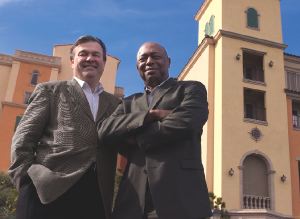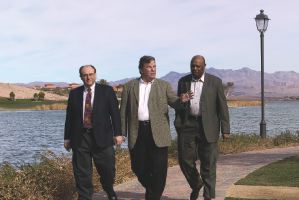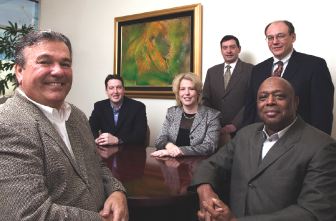
Black/White & Associates succeeds in hard and soft markets as traditional MGA, aggregator and program specialist
By Elisabeth Boone, CPCU

At top are Euclid Black, Chief Executive Officer of Black/White & Associates, and Paul White, President and Chief Operating Officer. Below, left to right, is Ira Dawer, Executive Vice President and head of the New Jersey office, with Euclid and Paul.

When it comes to helping retail agents navigate the complex market for specialty coverages, the partners who own Black/White & Associates head a team that's close knit, experienced, and focused.
Established in 1979 by Euclid Black and Paul White, the organiza-tion is still led by these founding partners, with Black serving as chief executive officer and White as president. The organization has offices in Las Vegas; Oakland, California; Palm Springs, California; Chicago; Kinnelon, New Jersey; and Richardson, Texas. Black/White's strategy involves acquiring specialty insurance operations that hold a dominant market position within their geographic areas. Black/White blends a strong centralized financial and administrative structure with a decentralized operating structure to give its affiliates both flexibility and support.
"When we started Black/White in San Francisco in 1979, we didn't want to be just another wholesaler; we wanted to meet a genuine need," Black says. "We determined that independent agents needed high-quality, aggressive brokering. In those days, there were brokers like Sayre & Toso, Swett & Crawford, and Cravens, Dargan, who worked mainly with the big houses. No one was paying attention to the two- or three-man shops. Paul and I resolved that we would do an outstanding job of brokering to that smaller independent agent who was being overlooked by the big guys," Black says. "We opened our doors and began to line up brokers in the San Francisco area. We pounded the pavement day after day, and ultimately we signed up some 100 brokers."
When Black/White was established, the property/casualty business was just emerging from an extremely hard market. "It was tough to find carriers," Black observes, "but we persevered. We tracked down every lead, hounded everybody, and eventually we were appointed by several companies. The problem in those first few years," he notes wryly, "was that about every third carrier we signed up with went out of business."
In those early days, Black says, he and White saw programs as an attractive business-building opportunity. "Programs are good, because they bring people in the door," Black comments. "We started with umbrella, products liability, and general liability, and then we moved into property. In our first year we wrote an umbrella program for Chevron dealers nationwide, and then we started writing entertainment business, insuring major boxing matches around the country for transmission breakdown in the pre-cable and satellite days. We insured matches involving fighters like Muhammad Ali, Larry Holmes, and Sugar Ray Leonard. It was fun," Black continues; "the only problem was wondering when we'd get our next account."
Hard market spurs growth
The onset of the next hard market, in 1984, proved to be a boon for the fledgling organization. "We doubled our volume in the first year of the hard market, and we doubled it again in the second year," Black says, "primarily because we had one of the few pens for social services, and to this day that program is the premier product in our agency." The program was written by AIG; it subsequently was moved to Safeco. During the mid-1980s and early 1990s, Black/White entered into MGA contracts with a number of carriers. "We did some brokerage business, but we did mostly MGA work and programs," Black says. "During the hard market we were able to do some business out of state because we had admitted paper with AIG. When we tried to go out of state with our MGA pens, we ran into a problem: most MGA carriers had territories. They liked doing business with us in California, but they didn't need us in, say, Washington State. California is a great state, but we had literally hundreds of competitors, and it was very hard to grow the enterprise. We tried opening offices in various locations throughout the state, as well as in Seattle and Hawaii, but it didn't work. A big part of the problem was that we couldn't differentiate ourselves.
"At this point, in the early 1990s," Black continues, "we looked at each other and asked: 'What do we do better and differently from anybody else?' The answer was: 'programs.' We decided we needed to focus on programs and become national. Between 1995 and 1998 we disposed of all our MGA and most of our brokerage business, and we became a program shop." To go national, both Black and White realized that they would have to offer more than one program, and they also would need to build a distribution system. "We embarked on a strategy of buying other specialty wholesalers and merging their operations into ours," Black explains.
In 1998 Black/White bought Western General, an MGA in Salt Lake City that specialized in casinos, and subsequently closed that office and moved the operation to Las Vegas. At the time it was acquired by Black/White, Western General was a $4 million agency. Today, Black says, its volume is about $15 million.
At the end of 1998 Black/White opened an office in Richardson, Texas, a suburb of Dallas, under the leadership of Mike Mullens, southwestern marketing director. The office markets exclusively in Texas and since 1998 has grown from less than $500,000 to $7.5 million in social service business, making it the second largest state for that product.
In 1999 Black/White acquired a professional liability specialty underwriter based in northern New Jersey, which writes a wide variety of risks and also has a program to insure hard-to-place attorneys. Since it was acquired, that operation's volume has increased from $4 million to some $17 million, Black says. The New Jersey office is headed by Ira Dawer, executive vice president.
In 1999 Black/White merged with R.E. Lee in Orange County, California, whose specialty was workers compensation. "We had a lot of comp business but no connections," Black says. "This merger gave us the access we needed. Unfortunately," he says ruefully, "right after that there was a meltdown in the California comp market. Still, we retained one excellent market, Golden Eagle, which we use primarily to provide standard lines to agents who are too small to have their own facilities." The Palm Springs office operates under the direction of Gloria Nelson, vice president-producer appointments.
Black/White's newest office was opened late last year in Chicago under the direction of David Hanes, who has a strong background in both primary insurance and reinsurance as well as in brokerage. The Chicago office will focus on marketing Black/White's premier product, the social services program.
Becoming an aggregator
The Lee merger, Black says, "was our foray into the aggregation business. Later that year we hired a young man from The Hartford, who brought with him the company's small commercial BOP program. At that time we formally entered the aggregation business. We started an operation in January of 2000 and in 2003 it had about $11.5 million in aggregation business. It's going great guns, growing by 50% to 70% a year. This year we plan to bring another producer into this operation."
Most aggregation models are built around writing BOP and similar kinds of business, Black observes. "We're still doing that, but we've also put together a large lines aggregation unit with markets like Hartford, CNA, Safeco, and Golden Eagle," he says.
"We're bringing in specialists whose job is to help agents gain access to markets with big capacity where they need leverage. A lot of agents with a $500,000 or $1 million account may have only one or two markets where they have any real clout, because they don't often write large accounts. We have a couple of dozen accounts of that size, with two or three working at any one time. We have excellent partnerships with our markets because of the volume and quality of the business we bring them." The large lines aggregation model is successful, Black comments, because it opens doors to high-capacity markets for retail agents and also because it helps Black/White's carriers reach a broader marketplace.

Over the last several years, Black observes, Black/White has undergone a major metamorphosis, from traditional MGA to program specialist and aggregator. "It's very hard to reshape yourself," he remarks, "but we've done it. We've encountered more than our share of problems along the way--losing a market, reinsurance falling apart--but we've learned from our experience, and in 2003 we put about $85 million worth of business on the books. That's up from $20 million five years ago."
Scale equals growth
Much of Black/White's impressive growth over recent years, Black remarks, can be attributed to its strategy of acquiring small books of business and then giving them scale. "Four million dollars in gaming became $15 million; $4 million in professional liability became $16 million, and so on," he says. With offices throughout the country, Black/White chose to provide centralized financial and administrative support to help individual offices improve their performance while at the same time achieving significant economies of scale. "Some costs can be leveraged very easily," Black comments. An example is the agency's investment in technology. "The incremental cost of adding components is tiny compared with the initial cost: the installation, monitoring, and training," he says.
Scale also is a big factor in the area of company representation, Black notes. "If you're writing $100 million, but you're doing it with 20 companies, it's very hard to achieve any real efficiencies, because each company is different," he explains. "We're in the program business, so when a program turns out to be successful, we can take it into additional states at a very small incremental cost. For example, in our Oakland office, we've quadrupled our social services volume with less than double the staff. That's all because of scaling. In fact, our home office staff is smaller today than it was five years ago. If we find a business opportunity or a book of business in another state, we can execute at the drop of a hat," he asserts.
As president of Black/White, Paul White speaks enthusiastically about the agency's markets. "All the markets we do business with are profit driven rather than volume driven," he says. "We want to help our company partners be profitable, because we understand that that's an important factor in maintaining long-term relationships with them. Most of our carriers," White continues, "are making major changes in their corporate strategies. We believe they'll keep us as their partner, because we fit in with their strategies when it comes to risk selection and profit objectives.
There's nothing we can do about competitors that charge prices that don't make sense to us," White asserts. "We have a pretty good handle on what makes money for our carriers, and we stick to that. Sometimes it means losing business, but we try to focus on service and the quality of the paper we represent, and on providing the most comprehensive coverage available for the products we offer. Insureds who are looking for longevity and quality can count on us."
Remaining a stable force through hard and soft markets is key to Black/White's success in its challenging specialty arenas. "In the hard markets of the mid-1980s and the early 2000s, we had to take some stiff actions, but at the end of the day we came out with the same carriers we went into it with," Black says. "The truth is, we both made more money, and we were able to bring on a large number of new clients because they needed consistent capacity. A lot of people did well in the hard markets because they could charge outrageous prices as the market of last resort," he continues. "For the most part, we were a consistent market. Coming out of the mid-'80s hard market, we found that where we had proprietary or exclusive products, we were able to retain a significant share of our clients. We're writing the same accounts today, in many cases, that we wrote 20 years ago," he says with pride.
"We represent leading markets like Safeco, Hartford, and United National," Black says. "Those companies are tough customers. They don't take prisoners; if you're not doing things right, you won't last with them. So we're not concerned about finding the cheapest capacity or the most naîve capacity. We're very conservative in selecting our business partners. We want to work with carriers that have a focus and know where they're going."
That same criterion applies to the retail producers with whom Black/White works. The agency currently has relationships with almost 1,600 retailers and is adding some 20 new producers each month, Black says. "We take on about 200 or 300 new relationships a year, many through mergers and acquisitions," he notes. To ensure the quality of its retail force, Black/White strictly enforces its credit and collection policies. "It's for their protection as well as our protection," Black says. "We have a centralized accounting facility, and we're constantly working on creating uniform systems and procedures so our producers can use their time to sell and build relationships with their clients."
Although Black/White's premier offering is a program for social services risks, the agency offers a wide array of other programs and products. (See box on page 59.)
Managing growth
Over the 25 years of its existence, Black/White has achieved impressive growth both despite and because of prevailing market conditions. "We believe in growth, and we're focused on growing 20% to 25% a year," Black asserts. "We were growing as fast in the soft market as we were in the hard market."
Adds White: "We didn't try to get ahead of ourselves. In all probability, we could be twice as large as we are now, but I think it would have cost us in maintaining long-term relationships with our clients and carriers. We have not sought growth at the expense of these relationships, and in the long run we think we've gained more of an advantage over our competitors because of our consistency."
Focused, disciplined, and experienced, the owners of Black/White & Associates have devoted a quarter century to building a stable, high-quality specialty lines organization and to creating strong partnerships with both carriers and retail producers. Conscientious, conservative, and consistent, Euclid Black and Paul White are proving every day that when Black meets White, the result is growth, profits, and enduring relationships. *

Available in California, Arizona, Illinois, New Mexico, Nevada, Oregon, Washington, Utah, Ohio, Indiana and Colorado. Written through an A-XII nonadmitted carrier, the package provides property, crime, and commercial liability coverage. Eligible risks are apartment buildings with five or more units. The minimum premium is $2,500.
Businessowners policy (BOP)
Available in all states except Alaska and Hawaii. Written through A+ rated carriers, the program's eligible classes are office, retail, wholesale, contractors, manufacturers, and service garages. The minimum premium is between $250 and $1,000.
Gaming/hospitality program
Available in Nevada, Utah, Idaho, South Dakota, Colorado, and Arizona. The program provides property, liability, auto, and umbrella coverage. Eligible classes are gaming establishments, hotels/motels, restaurants, bars, gift shops, and bingo. The minimum premium is $5,000.
Directors and officers
Available nationwide to 501(c)3 nonprofits and for-profit organiza-tions; minimum premium is $1,000.
Products liability facility.
Available nationwide and written through an A++ rated carrier. Eligible classes include heavy construction, metal fabrication, plastics/rubber manufacturing, chemical manufacturing, and food processing. The minimum premium is $7,500.
Professional liability products
Available nationwide and written through A rated carriers. The primary focus is hard-to-place attorneys; also eligible are miscellaneous classes such as auctioneers, real estate agents, claims adjusters, employment agencies, court clerks, tax preparers, land surveyors, escrow agents, third-party administrators, title agents, and property managers. The minimum premium is $2,000. Coverage is written on a claims-made and reported form with a 12-month discovery period. Prior acts coverage is available.
Property/casualty binding facility
Available for premises/operations exposures in most western states, including California, Arizona, Nevada, Utah, Idaho, Colorado, and Montana, and written through A rated nonstandard carriers. Provides coverage for property, inland marine, and general liability (defense outside limits with both occurrence and claims-made forms available). Eligible classes include habitational, commercial, new ventures, manufacturing, vacant buildings, lessor's risk only, and distributors. The minimum premium is $1,000.
Social service brokerage facility
Available nationwide to nonprofit social service agencies and written through A rated carriers. The package provides property, fidelity, inland marine, EDP, boiler and machinery, general liability, automobile, professional liability, abuse and molestation, umbrella, and D&O. Eligible classes are foster care, adoption agencies, residential care homes, and new operations. The minimum premium is $1,200.
Social service program
Available in all states except Alaska, Hawaii, Louisiana, North Dakota and South Dakota and written through an A XIV rated carrier. The package provides property, fidelity, casualty, inland marine, EDP, auto, professional liability, sexual misconduct, directors and officers, boiler and machinery, umbrella, life, benefits, medical, and key person insurance. Eligible classes include Head Start programs; schools and group homes teaching vocational and living skills; youth programs; food banks for the disadvantaged and "meals on wheels" for shut-ins; medical clinics; crisis intervention and counseling services; detox facilities; drug and alcohol recovery facilities; foster care (limited); independent living facilities, and assisted living facilities. The minimum premium is $1,200.
Umbrella/excess liability products
Available nationwide and written through A rated carriers. Eligible classes include habitational, manufacturing, surface mining, retail, wholesale, service, contractors, transportation, and nonprofit entities. Limits are available up to $15 million, and the minimum premium is $1,500.
For more information:
Black/White & Associates
Phone: (702) 856-0900
eb site: www.bwins.com